 There are three North American species of bear: the brown (or grizzly), the American black bear, and polar bears. Black bears are the smallest of the three, with adults typically ranging from 120 to 200 cm in head-and-body length, and 70 to 105 cm in shoulder height. American black bears can be distinguished from grizzly bears by their smaller size, their less concave skull profiles, their shorter claws and the lack of a shoulder hump. 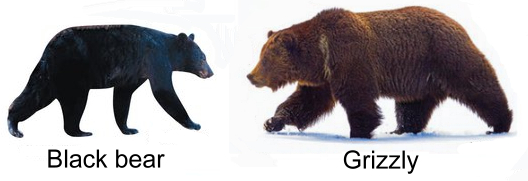 American black bears come in a variety of hues, from black to chocolate to brown through blonde to cinnamon, and even white. Only 70% of all American black bears are actually black. The American black bear is the continent's most widely distributed bear species. It is an omnivore, with a diet varying greatly depending on season and location. It typically lives in largely forested areas but will leave forests in search of food, and is sometimes attracted to human communities due to the immediate availability of food. 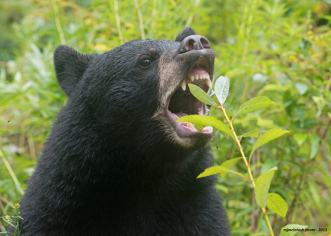 Up to 85% of a black bear's diet consists of vegetation, although when initially emerging from sleep in the spring, they will look for carrion from winter-killed animals, or newborn ungulates such as mule and white-tail deer fawns.
Up to 85% of a black bear's diet consists of vegetation, although when initially emerging from sleep in the spring, they will look for carrion from winter-killed animals, or newborn ungulates such as mule and white-tail deer fawns. As the temperature warms, American black bears seek new shoots of many plant species, especially new grasses and wetland plants. Young shoots and buds from trees and shrubs during the spring period are often the only digestible foods available at that time. During summer, the diet largely comprises fruits, especially berries and soft nuts. During the fall, hazelnuts, oak acorns and whitebark pine nuts may be consumed by the hundreds each day by a single bear. American black bears are highly dexterous, being capable of opening screw-top jars and manipulating door latches. They also have great physical strength, and can run at speeds of 40 to 48 km/h. American black bears have eyesight and hearing comparable to that of humans, but their keenest sense is smell, which is about seven times more sensitive than a domestic dog's. They are strong swimmers, swimming for pleasure and to feed (largely on fish). They can climb trees to escape enemies. Black bears may be active at any time of the day or night, although they mainly forage by night, especially if they are near human habitations. They tend to be territorial; they mark their territories by rubbing their bodies against trees and clawing at the bark. Bears communicate with various vocal and non-vocal sounds. Tongue-clicking and grunting are the most common sounds; when at ease, they produce a loud rumbling hum. During times of fear or nervousness, bears may moan, huff or blow air. Warning sounds include jaw-clicking and lip-popping. In aggressive interactions, black bears produce guttural pulsing calls that may sound like growling. 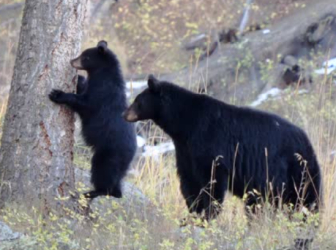 Sows usually produce their first litter at the age of 3 to 5 years. The gestation period lasts 235 days, and litters are usually born in late January to early February. Litter size is between one and six cubs, typically just two or three.
The average lifespan of a black bear in the wild is 18 years.
Sows usually produce their first litter at the age of 3 to 5 years. The gestation period lasts 235 days, and litters are usually born in late January to early February. Litter size is between one and six cubs, typically just two or three.
The average lifespan of a black bear in the wild is 18 years.
With the exception of the rare confrontation with an adult grizzly or a wolf pack, adult black bears are not usually subject to natural predation. Cubs tend to be more vulnerable than adults, with predators including bobcats, coyotes, cougars, wolves, grizzlies, and other black bears. Once out of torpor, mother bears may be able to fight off most potential predators. Even cougars will be displaced by an angry mother bear if they are discovered stalking the cubs. 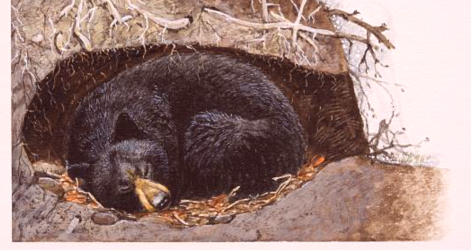 NOTE:
NOTE:Due to recent discoveries about the metabolic changes that allow black bears to remain dormant for months without eating, drinking, urinating or defecating, most biologists have redefined mammalian hibernation as "seasonal reduction in metabolism concurrent with scarce food and cold weather". As a result, black bears are now considered to be hibernators. Hibernating bears spend their time in hollowed-out dens in tree cavities, under logs or rocks, in banks, caves, or culverts, and in shallow depressions. Although naturally-made dens are occasionally used, most dens are dug out by the bear. After emerging from their winter dens in spring, they wander their home ranges for two weeks so that their metabolism accustoms itself to activity. American black bears are fond of honey, and will gnaw through trees if hives are too deeply set into the trunks for them to reach with their paws. Once the hive is breached, the bears will scrape out the honeycombs with their paws and eat them, regardless of stings from the bees. Bears that live in northern coastal regions (especially the Pacific Coast) will fish for salmon during the night, as their black fur is easily spotted by salmon in the daytime. In Labrador, American black bears are exceptionally carnivorous, living largely off caribou, usually young, injured, old, sickly or dead specimens, and rodents such as voles. This is believed to be due to a scarcity of edible plant life in this sub-Arctic region, and a local lack of competing large carnivores (including other bear species). Like grizzlies, American black bears try to use surprise to ambush their prey, and target the weak, injured, sickly or dying animals in the herds. Once a deer fawn is captured, it is frequently torn apart alive while feeding. Interestingly, there is at least one record of an American black bear killing a wolverine in a dispute over food in Yellowstone National Park. 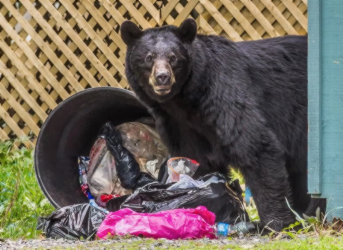 Although an adult bear is quite capable of killing a human, American black bears typically avoid confrontations. Unlike grizzly bears, which became a subject of fearsome legend among the European settlers of North America, black bears were rarely considered overly dangerous, even though they lived in areas where the pioneers had settled.
Although an adult bear is quite capable of killing a human, American black bears typically avoid confrontations. Unlike grizzly bears, which became a subject of fearsome legend among the European settlers of North America, black bears were rarely considered overly dangerous, even though they lived in areas where the pioneers had settled.
American black bears rarely attack when confronted by humans and usually only make mock charges, emit blowing noises and swat the ground with their forepaws. The number of attacks on humans is higher than those by grizzlies in North America, but this is largely because there are many more black bears. The majority of attacks have happened in national or provincial parks, usually near campgrounds, where the bears had habituated to close human proximity and food. Moreover, compared to grizzly attacks, aggressive encounters with black bears rarely lead to serious injury. Most attacks tend to be motivated by hunger rather than territoriality, so victims have a higher probability of surviving by fighting back rather than submitting. Also, female black bears are not as protective of their cubs, and rarely attack humans in the vicinity of the cubs. |